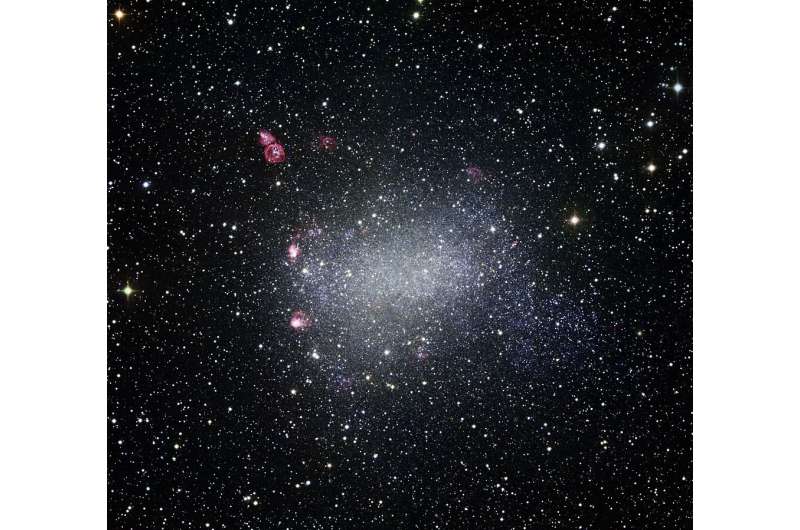June 8, 2022 report
Study sheds more light on stellar populations of NGC 6822

Using the Subaru telescope, an international team of astronomers have performed deep multi-band photometric observations of a dwarf irregular galaxy known as NGC 6822. Results of the observational campaign, presented May 30 on arXiv.org, deliver important insights into stellar populations of this galaxy.
At a distance of some 1.63 million light years, NGC 6822 (also known as Barnard's Galaxy) is a dwarf irregular galaxy in the Local Group. It is one of the closest galaxies to the Milky Way, but lies just outside its virial radius. The galaxy is about 7,000 light years in diameter and hosts a spatially extended system of globular clusters (GCs).
NGC 6822 is an excellent observational target as its position on the sky is such that it can be observed from both the northern and the southern hemisphere. Its modest distance allows many multi-band investigations ranging from the optical to the near-infrared (NIR) and to the mid-infrared (MIR). Moreover, its mean metal-intermediate chemical composition and the identification of solid young, intermediate-age and old stellar tracers and its apparent isolation make NGC 6822 a very interesting laboratory for stellar pulsation and evolution.
That is why a group of astronomers led by Maria Tantalo of University of Rome Tor Vergata in Italy, has conducted an accurate multi-band photometry of NGC 6822 with the Hyper-Suprime-Cam (HSC) at Maunakea Subaru Telescope. The HSC dataset was complemented with multi-band images collected with the wide field imager MegaPrime available at the Canada-France-Hawaii Telescope (CFHT), with the Dark Energy Camera (DECam) on the Blanco telescope at Cerro Tololo Inter-American Observatory (CTIO), and with the Wide Field Camera (WFC) mounted on the Isaac Newton Telescope (INT) at La Palma.
"This is the first paper of a series aimed at studying the stellar content of NGC 6822 by taking advantage of optical photometry collected with wide field imagers available at the 4–8m class telescopes," the researchers wrote.
In result, Tantalo's team obtained a photometric dataset covering an area of two square degrees across the center of NGC 6822 with three different photometric bands. In total, in these three photometric bands, they performed about 40 million photometric measurements of objects across the entire field of view. The final catalog includes more than 1 million stars with at least one measurement in two different photometric bands. This makes it the widest and most homogeneous photometric dataset ever collected for a nearby dwarf irregular galaxy, with the exception of the Magellanic Clouds.
The study found that young, intermediate and old stars in NGC 6822 showcase different radial distributions. The old stellar population appears to be spherically distributed and extends to radial distances larger than previously estimated (about 1 degree). When it comes to the young population, it displays a well-defined bar and a disk-like distribution that is off-center compared with the old population.
Furthermore, the research found that the carbon-rich stars in NGC 6822 are more centrally concentrated and have structural parameters similar to both young and old stellar tracers. The astronomers also estimated a mean population ratio between carbon and M-type stars that turned out to be at a level of 0.67. This suggests that the galaxy's asymptotic giant branch (AGB) stars have a mean iron abundance of approximately -1.25.
More information: Maria Tantalo et al, On the dwarf irregular galaxy NGC 6822. I. Young, intermediate and old stellar populations. arXiv:2205.15143v1 [astro-ph.GA], arxiv.org/abs/2205.15143
© 2022 Science X Network





















